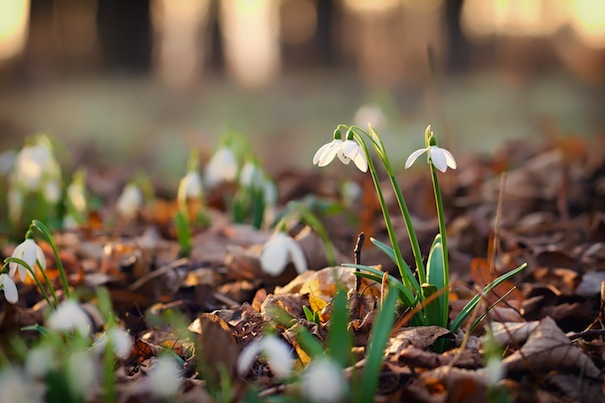
In early spring there is plenty to be getting on with in the garden..
Spring colour
For some instant colour in the garden, buy pots of daffodils and tulips and plant with pansies and primroses. Look out for signs of colour in your garden. Plants such as Hamamelis (Witch Hazel), winter flowering Jasmine and Hellebores will all be showing signs of colour that suggest spring is on its way. Plant snowdrops at this time of year – they will settle much easier from green plants than planting bulbs in the autumn.
Get pruning and dressing!
Roses can be pruned now, along with shrubs that will flower on this years’ growth such as Buddleja and Elder. Always prune roses back to an outward facing bud approximately 20cm above ground level. Remove any weak, diseased or crossing stems. Mulch and top dress shrub and herbaceous borders. A good mulch with well-rotted manure will help to deter weeds during the growing season and a top dressing with a general fertilizer will give plants a good start to the season. Lime hating plants such as Rhododendrons and Camellias can be given a dressing of ericaceous fertilizer specifically designed for lime haters as it will contain all the extra trace elements that they need.
Valentines roses
Valentine’s Day and Mothering Sunday are ideal times to buy a living gift for a loved one. Instead of buying red roses that will be over in a matter of days, buy a rose plant that will remind the receiver of you for many years to come. For Mothering Sunday, inexpensive primroses, exotic orchids, gift basket arrangements or a spring flowering shrub to pop into the garden will all do the trick.
Hanging baskets
Plug plants such as fuchsias, geraniums and hanging basket plants start arriving in garden centres during the second week in February. There’s a huge range of varieties to choose from. If you do decide to buy some of these small plants remember they need to be nurtured with warmth and light to get them growing. A sunny windowsill during the day is okay, but if we’re likely get a frost at night, take them off before you close the curtains.

Vegetables
As soon as you can, pop into the garden centre and get your seed potatoes then start them ‘chitting’ (shoots beginning to grow) in old egg trays inside somewhere frost free. Remember you can grow seed potatoes in pots inside as early as you like so long as they are protected from frost. Onion Sets, Shallots, Asparagus and Garlic should all be available from mid February. Onion and Leek seeds take some time to germinate and should be sown as soon as possible. Get an early crop of Rhubarb by covering clumps with a large pot or dustbin, new sticks will soon shoot up in the dark. Don’t be in a rush to sow Tomato, Pepper or Cucumber seeds as once the plants are growing they’ll need plenty of heat and good light until the weather is warm enough to plant them outside in May.
Lawns
If it’s cold and frosty you’re better keeping off the garden, especially the lawn. If your lawn is waterlogged from all the rain we’ve had keep off it until it’s dried out somewhat and then you can go over and aerate to improve the drainage. Shrubs can still be moved if the weather is mild, once replanted give them a good soak with water to settle them into the ground. If we get a severe frost go round and gently firm newly planted shrubs back into the ground if they become raised up. Continue to keep vulnerable shrubs covered with fleece – a late frost in February or March can cause permanent damage to shrubs like Hebe, Ceanothus and Cordyline.
Greenhouses
Whilst you have very little in your greenhouse, February is the ideal time to turn it out, wash it down and disinfect it. Remove as much as possible from the greenhouse; wash down any staging, seed trays, pots etc. with a good detergent or greenhouse disinfectant. Then wash down the glass, again with a detergent or disinfectant to remove any algae, pests and overwintering eggs. Use a sulphur candle to fumigate the greenhouse. Having a clean greenhouse to start with ensures that seeds and plants get off to a good start.
Birds
Don’t forget our feathered friends; especially if the weather is poor provide peanuts, seeds and fat balls. Clean off bird tables regularly and remember to put out fresh water daily. Birds love the recently introduced specialist feeds – the robins and blue tits at the garden centre love the mealworm and sunflower hearts!
This month’s tips are provided by Ann Winwood of Lealans Garden Centre, Shipley.






